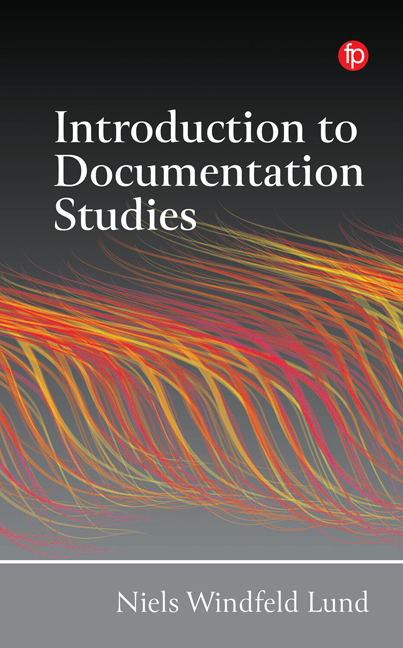 Introduction to Documentation Studies
Introduction to Documentation Studies Published online by Cambridge University Press: 28 March 2024
A simplistic account suggests that ideas of documentation began with Otlet and his colleagues, as a way of providing better access to the content of the greatly expanded volume of printed documents, and that the concept of a document was expanded by Briet with her talk of pebbles and stars and antelopes. This is, of course, grossly over-simplified; the documentary nature of diverse entities was recognized long before Briet, though documentary terminology was not used; see, for example, Strauß’s (2023) analysis of mineral collections in the early 19th century. But nonetheless, it is true that we have witnessed an expanded understanding of what a document – an item, physical or virtual, conveying meaningful information – might be, encompassing, inter alia, artworks and performances, landscapes and persons, buildings and oral utterances, human bodies and human remains, textiles and clothing, and more (Bawden and Robinson, 2022). For examples of this expanded horizon of documentation in the context of art, and with careful theoretical underpinning, see Gorichanaz (2019) and Kosciejew (2023).
This expansion owes much to the digital transition, and to the move into the informational environment of what Luciano Floridi (2014) has termed the infosphere. The new information reality of the infosphere, in which we spend our time onlife in seamlessly blended physical and digital information spaces, generates and supports new forms of document, differing both in quality and in quantity from what has come before. These may include documents which are multisensory, immersive, ephemeral, and ‘unreal’ (Robinson, 2015; Skowron and Stacewicz, 2023). Furthermore, many documents of all kinds, perhaps the majority, will be generated by artifical intelligence, rather than by humans, leading inevitably to ‘an immense spread of semantic garbage’ (Floridi and Chiriatti, 2021, 692).
In this emerging informational landscape, we cannot rely on pragmatism and common sense, nor even on professional precedent and good practice, to know how to deal with the documents of the present and the future. Theories and concepts of documentation are needed more than ever. These have been developed over the decades by scholars such as Otlet, Briet, Buckland, Frohmann, Day, Gorichanaz, Latham, Kosciejew, and Skare, and, by no means least, by the author of this book. Sometimes, theoretical perspectives may come from outside the information sciences.
To save this book to your Kindle, first ensure no-reply@cambridge.org is added to your Approved Personal Document E-mail List under your Personal Document Settings on the Manage Your Content and Devices page of your Amazon account. Then enter the ‘name’ part of your Kindle email address below. Find out more about saving to your Kindle.
Note you can select to save to either the @free.kindle.com or @kindle.com variations. ‘@free.kindle.com’ emails are free but can only be saved to your device when it is connected to wi-fi. ‘@kindle.com’ emails can be delivered even when you are not connected to wi-fi, but note that service fees apply.
Find out more about the Kindle Personal Document Service.
To save content items to your account, please confirm that you agree to abide by our usage policies. If this is the first time you use this feature, you will be asked to authorise Cambridge Core to connect with your account. Find out more about saving content to Dropbox.
To save content items to your account, please confirm that you agree to abide by our usage policies. If this is the first time you use this feature, you will be asked to authorise Cambridge Core to connect with your account. Find out more about saving content to Google Drive.